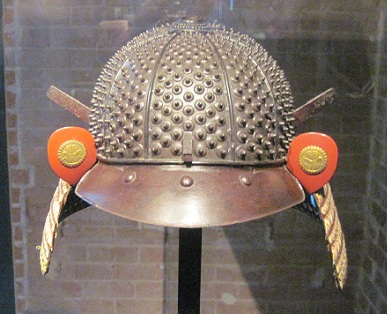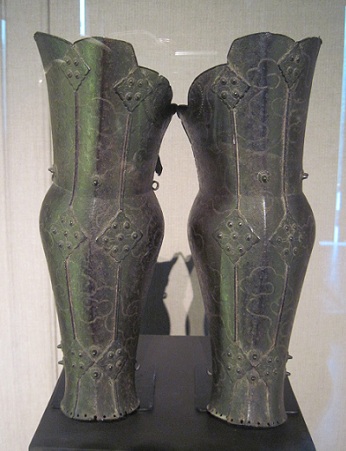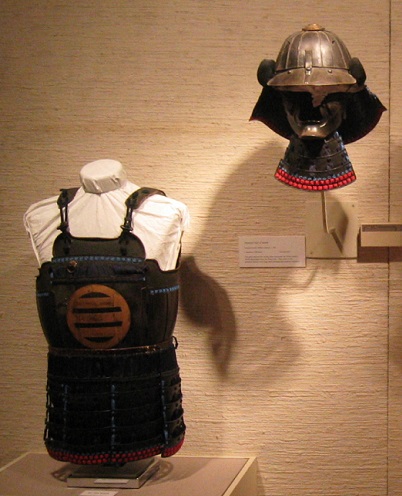Subject: samurai warrior
Culture: Muromachi Japanese
Setting: Onin War, early Sengoku Jidai, Japan 1467 - mid-16thc
Object: tōsei gusoku armor
* Metropolitan Museum of Art > Stone Gallery of Arms and Armor
"Helmet (Hoshi Kabuto)
Lacquered iron, stenciled leather, gilt copper, silver, shakudo
Muromachi peirod,
late 15th-16th century
The early bowl was probably relacquered and remounted with its present fittings in the eighteenth century
* Metropolitan Museum of Art > Stone Gallery of Arms and Armor
"Mask
Lacquered iron, hair, silk
Probably Muromachi period,
possibly 15th century
This early mask of great rarity is modeled on a character from the Noh drama: the happy old man (okina) with distinctive white eyebrows and beard."
* Metropolitan Museum of Art > Stone Gallery of Arms and Armor
"Cuirass of a Dōmaru
Iron, silk and leather laces, stenciled leather, gilt copper
Muromachi period,
15th century
* Metropolitan Museum of Art > Stone Gallery of Arms and Armor
"Cuirass of a Dōmaru
Lacquered iron and leather, silk, gilt copper
Muromachi period,
about 1550
This armor is believed to have been given by Daté Masamune (died 1636), one of the most famous daimyo of his time, to a high-ranking samurai in his service, Siraishi Bungo."
* Metropolitan Museum of Art > Stone Gallery of Arms and Armor
"Cuirass of a Haramaki
Lacquered iron and leather, stenciled leather and silk laces, gilt copper
Muromachi period,
late 15th-16th century;
probably relaced in the 18th century"
* Metropolitan Museum of Art > Stone Gallery of Arms and Armor
"Cuirass of a Haramaki
Lacquered iron and leather, leather and silk laces, gilt copper, stenciled leather
Muromachi period,
15th century"
* Metropolitan Museum of Art > Stone Gallery of Arms and Armor
"Bowl of a Helmet (Suji Kabuto)
Lacquered iron, gilt copper Muromachi period, early 15th century
This helmet bowl is one of the earliest examples of the melon (akodanari) shape, the typical form worn in the fifteenth and sixteenth centuries, and retains its original lacquered surfaces." ...
* Mabee-Gerrer Museum of Art > Weapons and Warriors
"Japanese Suit of armor
lacquered metal, ribbons (newer),
c.1500 ...
The gold crest on the breast plate represents the Miura family which descended from the Taira clan. They were a very powerful family with large land holdings and political influence."
* Mabee-Gerrer Museum of Art > Weapons and Warriors
"Japanese Suit of armor
lacquered metal, ribbons (newer),
c.1500" ...
* Harwood International > Samurai Collection
"Akodanari kabuto (melon-shaped helmet) Muromachi period, late 15th-early 16th century
Haruta School Iron, laquer, lacing ... 5.8 lbs. ...
The shape of this helmet, called akoda, is characteristic of the Muromachi period and means melon or pumpkin shaped. The bulbous form rises slightly higher in the back, resembling these shapes. The construction of this kabuto, with twelve plates covered in protruding rivets comprising the helmet bowl, is very unique. There is no other known example."
* Harwood International > Samurai Collection
"Tsubo suneate (shin guards)
Muromachi period,
15th-16th century
Iron, silver ...
This pair of shin guards is a rare type made completely of iron. As you can see from the suits of armor, suneate are usually made of small metal plates sewn onto fabric."



